What’s in Bloom, What to Plant, See and Do this Month!
March, wherever you garden, is the month for change and expectation. This fact is true for both tropical and temperate climate gardens. In all our locations, we have in common the beginning of warmth and the promise of summer.
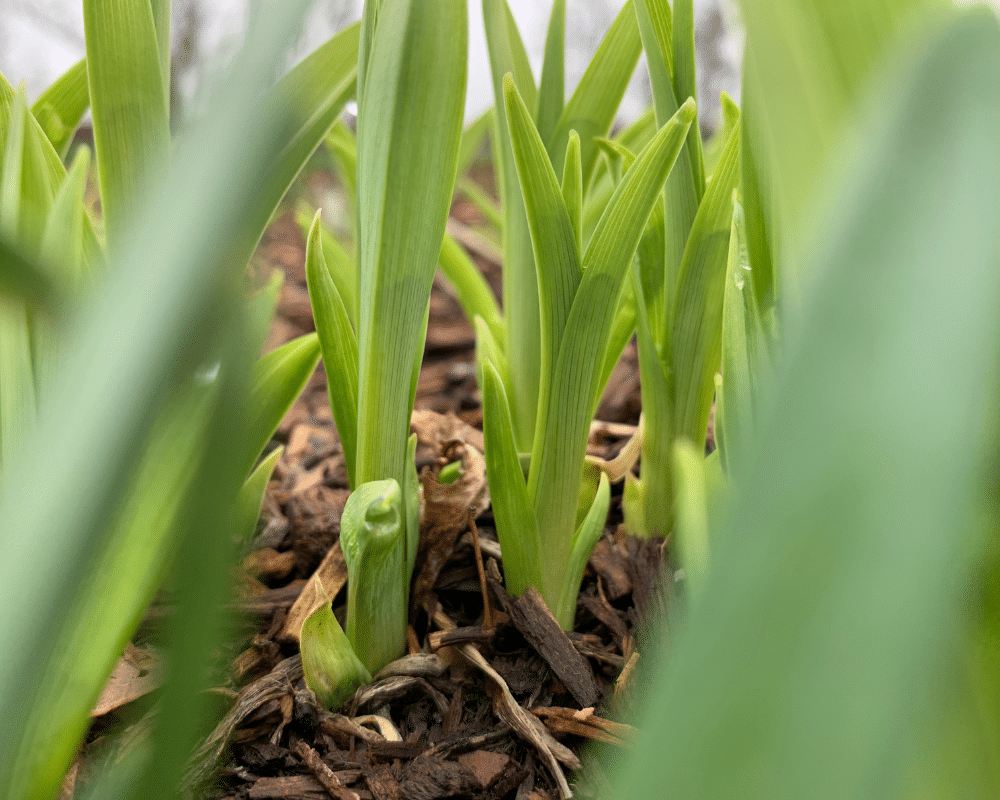
In your March garden you may have seeds indoors, seeds in the soil, or like us, you are harvesting every day and preparing for heat humidity and hurricanes!
We all revel in spring and feel the coming summer.
March is the Month of Expectation- in the Words of Gardeners
There are many inciteful comments about March, and often the best of those are made by gardeners. Emily Dickinson is not always remembered as a gardener, but she was an inventive one. She grew plants all her life, including tropical plants indoors in Amherst Ma and created a personal herbarium of over 400 species. (You can see it at Harvard University.) This is a favorite comment about March.
March is the month of expectation.
The things we do not know-
The persons of prognostication
Are coming now-
We try to show becoming firmness-
But pompous joy
Betrays us, as his first betrothal
Betrays a boy.
-Emily Dickinson
March Brings Spring to Gardens Everywhere
In March, warmth is on its way to all of our gardens. If you garden in a temperate climate, our subtropical conditions are different! But March brings the changes of spring to us all. March brought us Floridians our first decent rain in recent memory. On March 10, we felt a tremendous harsh rain at 2 am, the kind that wakes you up. (This followed a February without a single day of rain! and we needed to arrange for more irrigation.) In all climates, we prepare for spring growth.
What’s in Bloom in the March Garden Right Now
Tropical Flowering Trees
Flowering Trees are just as welcome in a tropical springtime as in other climates. So we mark the weeks of spring with the tree varieties in bloom. If you visit Florida this spring or want to plant in your own garden this little chart should be helpful.
I used pink and purple in the chart to highlight the popularity of the two colors, but you will find white, red, orange and yellow too.
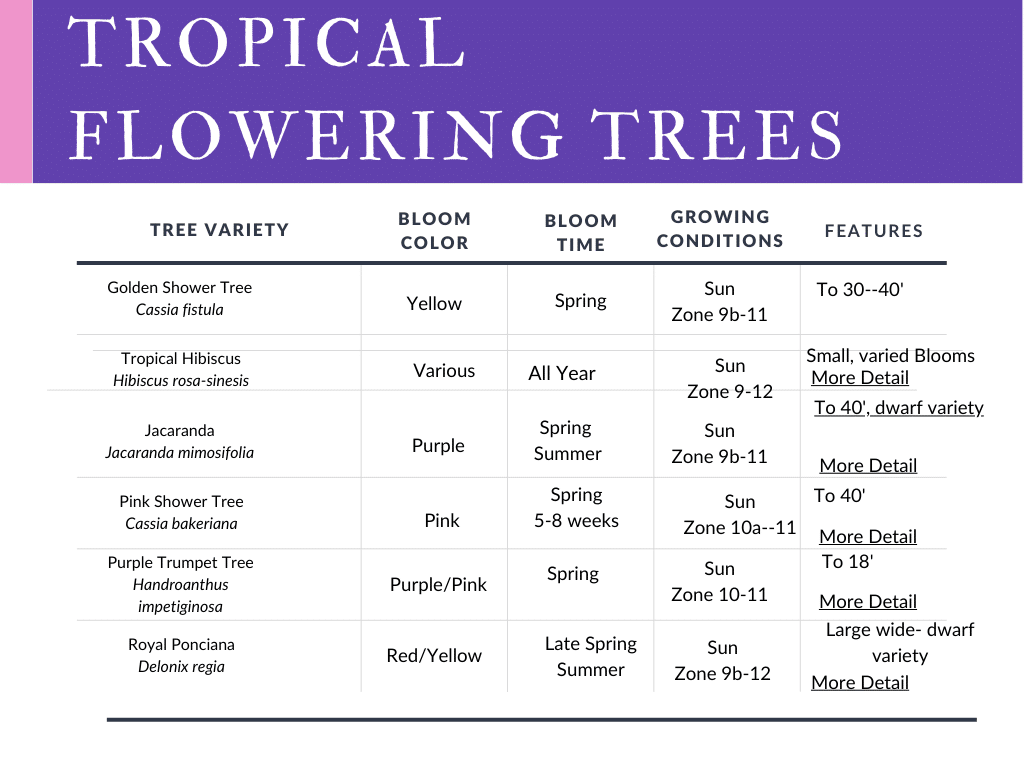
Romantic Drips of Graceful Shell Ginger
A friend gave us this plant, and we think of him whenever we view it.
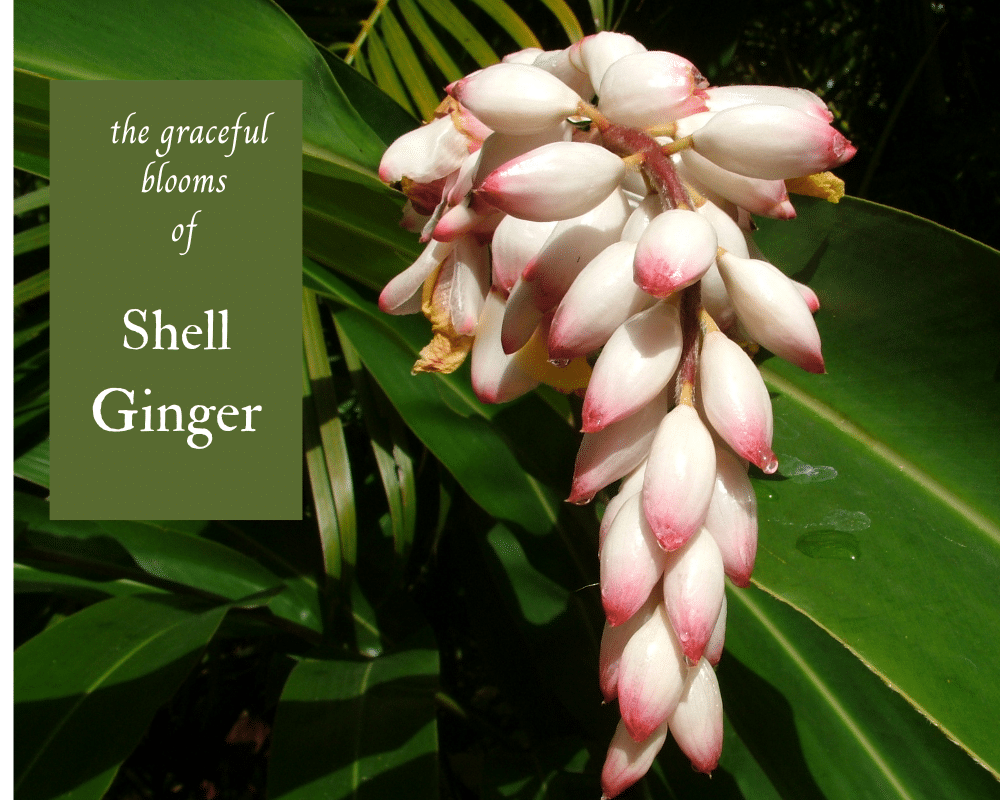
The graceful shell ginger, cut to the ground this winter, is blooming in elegant drapes of pink; the pondside plantings, a little late this year, are ready to bloom, and the bright winter annuals still prevail and it is warm enough for even long time Floridians to be in the pool!
Change is in the Air

The month of March around here is not just a joy for gardeners. It is ‘High Season’ in our coastal resort town. All winter the tourists show up in the grocery store wearing swimsuits and (maybe) beach coverups while we locals buzz through the crowds in fleecy vests!
Now, in March, we all dress the same, we can’t tell the tourists from the locals until they can’t find stuff and clog the checkout lines!
Each March is a Little Different for Us Gardeners
Some plants are blooming on schedule, but others, were cut back after Hurricane Ian, and some ensuing cold spells are late this year. The Seminole Dombeya blooms bright pink on top, and Plumeria flowers are late arriving but think hard about joining in, but the lush drooping Mussaenda is still holding out.
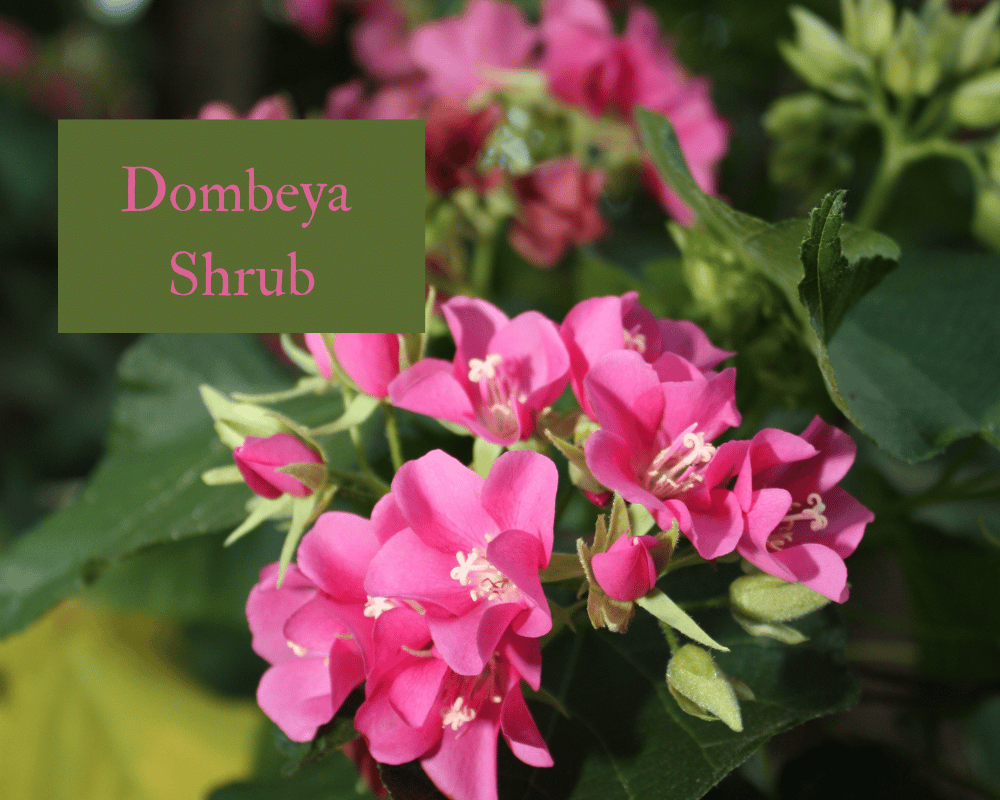
So, What is On Schedule and What is Late Getting Started?
Hibiscus are always in bloom, the low border of Mona Lavender and Bromiliads of many varieties both bloom and display foliage throughout the garden. Powder Puff shrubs and tall spires of Salvia buzz with bees all day. Shell Ginger, Seminole Dombeya and bright foliage plants like varicolored Croton and Elephant Ears in pots add color.
What’s Running Late This Year?
Mussaenda and Plumeria
Mussaenda is an evergreen flowering shrub native to the Philippines in hardiness zones 9-11, where it can reach 8′ in height. (In colder climates, you can overwinter it indoors.) Our plants, usually large by this time, are in tentative growth following Hurricane Ian. Plumeria is near to blooming but have yet to.
Vanilla Orchid
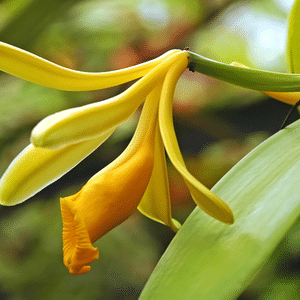
This is a vanilla orchid, it is a vining plant we grow up the trunks of palm trees and on a trellis for convenience. They grow beautifully up the trees and produce lovely delicate blooms in spring.
However, if you let them grow too tall it is very difficult to pollinate them, hence the wire trellis.
Warm days in January, followed by Hurrican Ian and some cold days in February have made the blooms late this year.
We are still waiting!
Bulbs we Plant in Spring for Summer Blooms
This week the big white box of pink caladiums arrived. I will be putting them in the ground using my favorite “Hori Hori Knife“.
The caladium is a tropical plant native to South America. It is in the Arum family and we prize it everywhere for its large and colorful foliage. I buy these in spring time directly from the growers in Lake Placid Florida, where the farmers produce, in one small American country town, 90% of the world’s supply of this ornamental plant. This year the supply is small due to extensive damage to the entire industry by Hurricane Ian.
My supplier (Happiness Farms, Lake Placid, Fl) could fill my needs, if not all of the color choices I had hoped for. So here is how they look!
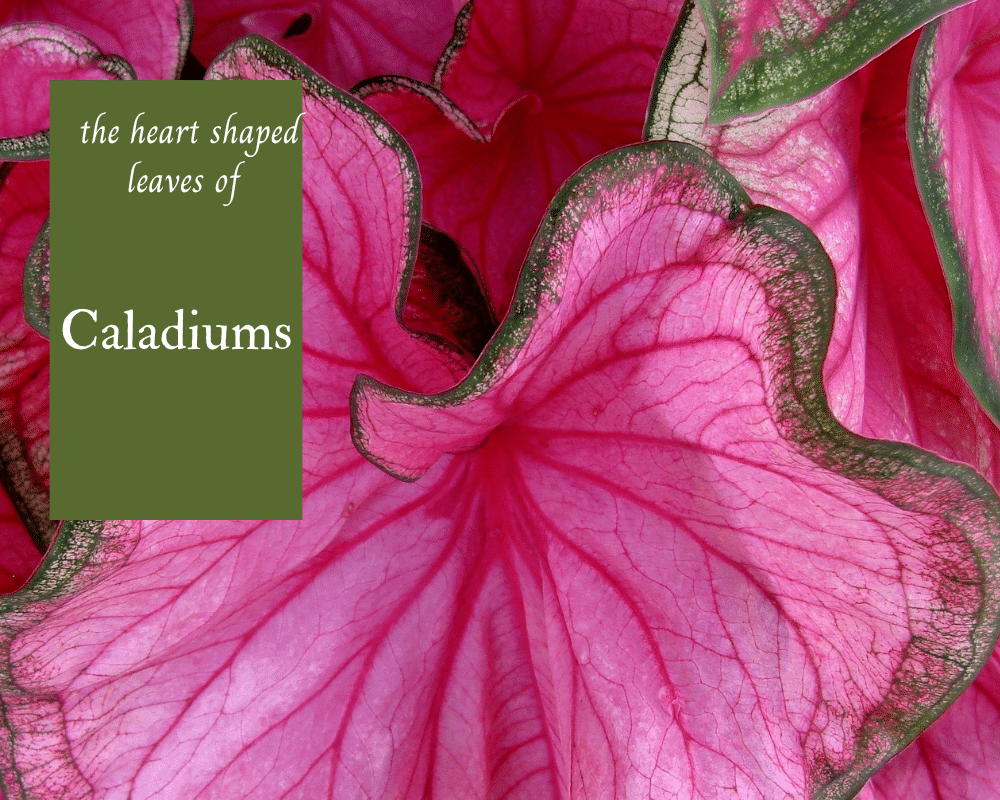
You can use these all summer in containers and save the bulbs for another year. Here is how to do that. In our climate they stay in the ground and reappear next year. Choose the pale colors and large heart shaped leaves for partial or full shade and the Lance shape with a heavier leaf, usually in a brighter color for sunny conditions.
Yes, We have Hostas!
The low growing hosta with vibrant foliage is a plant most everyone wants to grow. The problem in my zone 10a garden is finding one that does not require extended periods of cold to succeed. Finding a Florida native plant is not hard at all-but finding a Florida native human is a challenge. We come to Florida from cooler places and we bring our planting ideas.
Our state university has developed a “sun hosta” for all of us transplants to grow and it is a great pleasure. With bright green and white stripes and a handsome tall, trumpet shaped blossom it graces our partial sun areas as a brilliant groundcover.
We have planted these for several years and as we build areas of partial (rather than full) sun they thrive in the garden. They are reasonably drought tolerant, love good drainage and the hummingbirds entertain us daily!
Annual Plants
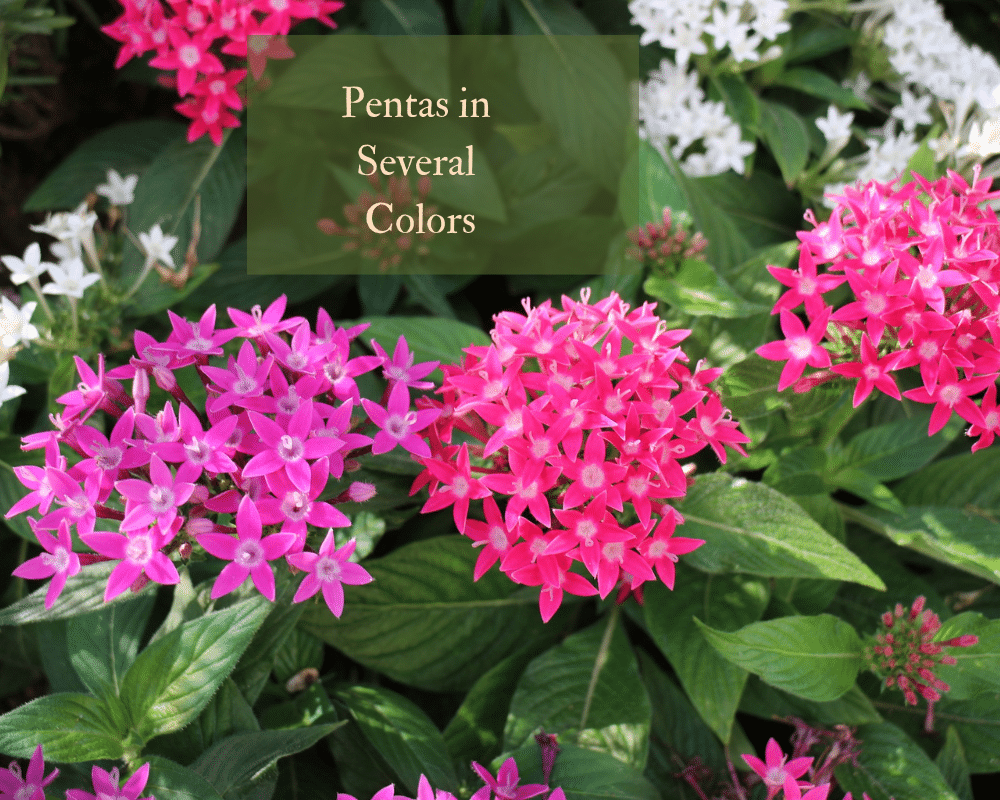
In March the winter annual flowers still shine. Our neighbors enjoy them and we should all have them until May. However as we add new bedding plants we will choose varieties (see what to plant, below) that will survive our hot and wet summers.
Yesterday we added giant golden marigolds to enhance a grouping of croton and a row of purple pentas to the pond-facing beds. They should handle our summer weather. And I uprooted the last of the pansies. Time goes on.
Vines
- Confederate Jasmine-Trachelospermum jasminoides: all year around this vine sports tiny leaves of dark and shiny green and in spring (and to some extent summer) the vine adds small scented white blooms all over.
- Passion Flower-Passiflora: This species of perennial vines will remain evergreen or return each year in zones 7-11. There are some varieties classified as annuals or shrubs. There are over 500 species.
- Sweet Almond-Aloysia virgata: I am stretching the truth here. Sweet almond is prized for long-lasting sweetly scented blooms, but it is a woody shrub with long branching tendrils that we use against a fence to twine up and disguise the potting bench with its tools. The appearance is that of a shrubby vine and it hides the fence better than vines we have tried before.
This piece is “How to Make an Entrance with Vines” it’s about a back yard project to create a pretty and shady enclosure for a seating area.
Temperature and Rainfall
This little chart will show you the temperature ranges to expect as a South Florida gardener (or visitor) this month.
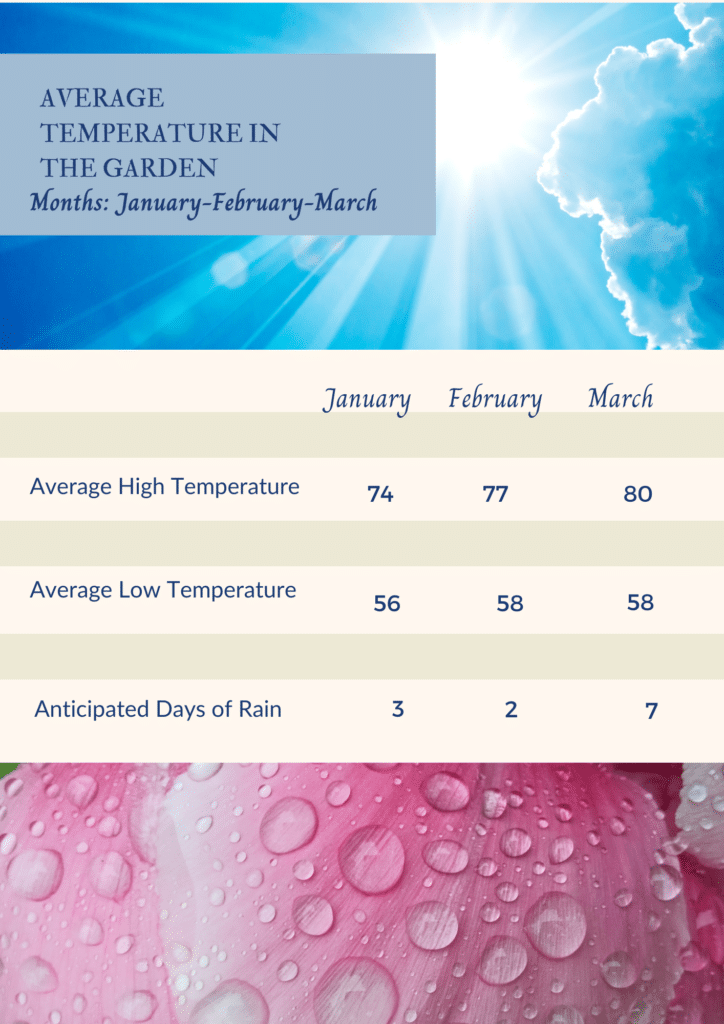
Learn to Plan for Hurricanes all Year Long
Our hurricane season starts in three months and runs from June 1 to November 30.
Use this button at the bottom of this page and sign up for my newsletter and download our best “12-month Hurricane Preparation Plan” if you like!
How did we figure this out? Good training and years of practice. We are a pair of Master Gardeners, volunteers working through our state University system to help neighboring gardeners. (You will likely have similar volunteers if you garden in most US states. Find them through your county extension service.)
Our Hurricane Prep Plan is everything we have learned as longtime Florida gardeners. Every planting or pruning decision is part of the plan. We hope it helps.
What Edibles are Ripening Now?
Citrus in Flower
The small kumquat tree is continuing its winter long display of fruit. As mentioned in the garden tools section I found a mealybug on one leaf and am treating it with neem oil. The citrus flowers on both trees (kumquat and key lime are late in arriving this year. We watch anxiously as we appreciate the long season of fruit.
Lettuce, The Everglades Tomato and Bountiful Herbs
In our small garden, edible beds are few. However, we raise a wide variety of herbs for cooking; the weather still supports our lettuce plants, and the tiny, sweet Everglades tomato are plentiful while still green.
It’s March-What to See this Month in South Florida
Here is a historic garden, house, and scientific workshop well worth a visit if you are in Fort Myers Fl, just north of our location. It is the Edison-Ford Winter Estate, riverfront in the old downtown section. This is my guide to visiting the estate and highlights its most prominent garden.
Wildlife in the Garden
The Humming bird Migration is On!
If you believe you live a high energy life consider the hummingbird in migration. They fly in daylight, from places in South America to northern summer homes. During the trip their tiny hearts beat 1260 times per minute and their wings flap 50-80 times per second. Starting north in January they will be in flight until about May. Here in south Florida they have been all about the garden and if we are nice to them we will have a good variety to watch throughout the summer. (There are also a small number of varieties that are native to Florida also.)
How to Attract Hummingbirds
First be alert. Be quick!!
In March-What to Plant Right Now
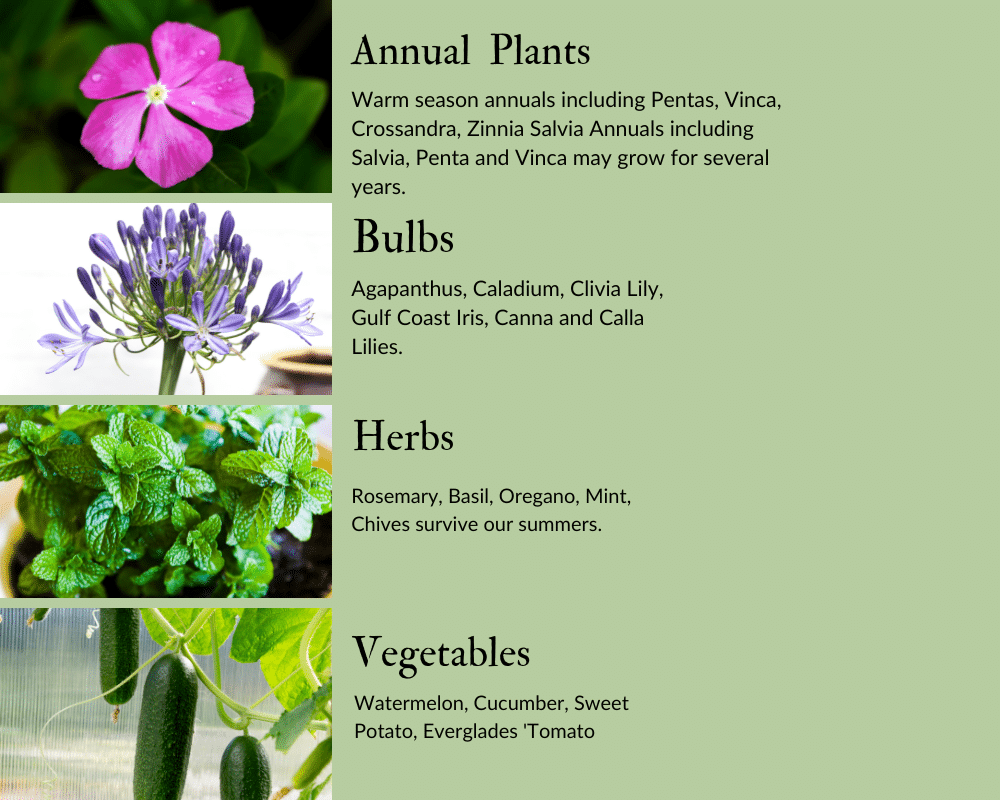
This March-What to Do in the Garden
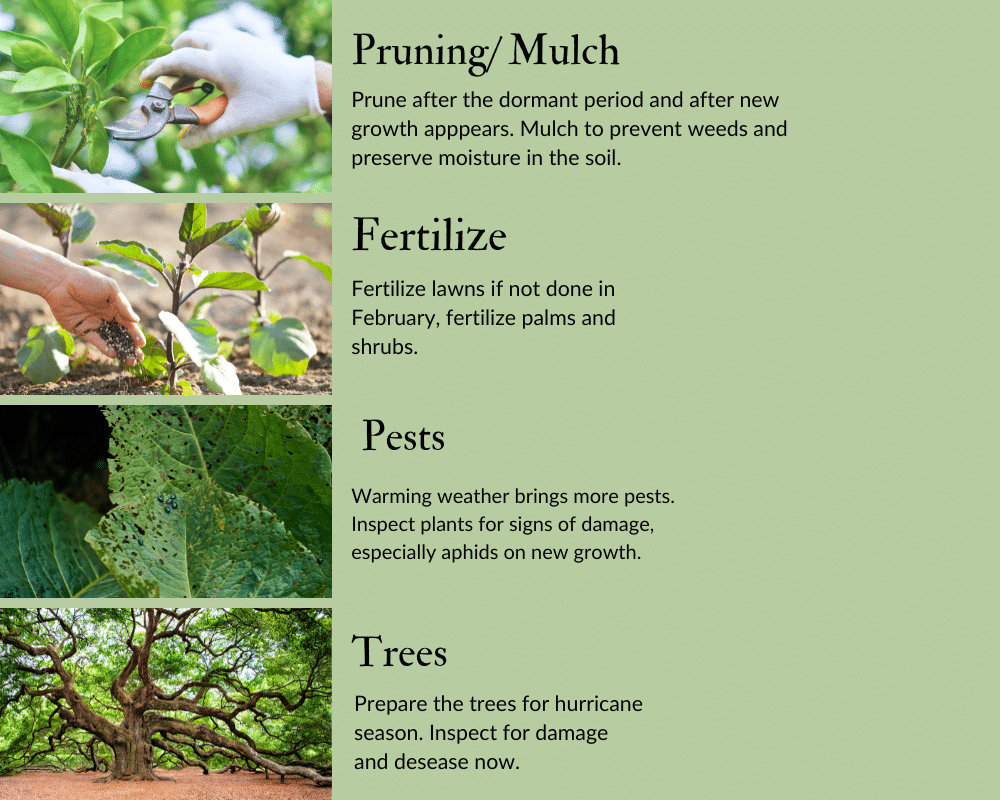
Good Books-What We are Reading this Month
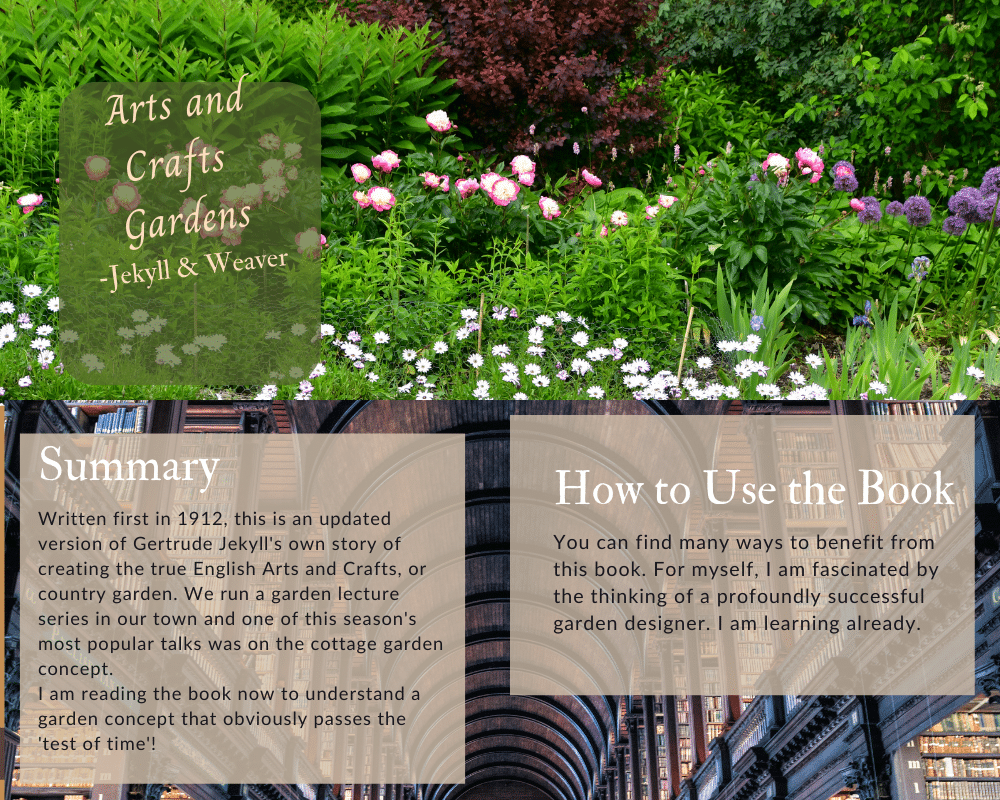
It’s March-Tools We Can’t Be Without
This month we are getting lots of use from two tools we would not be without.
The Hori Hori Knife
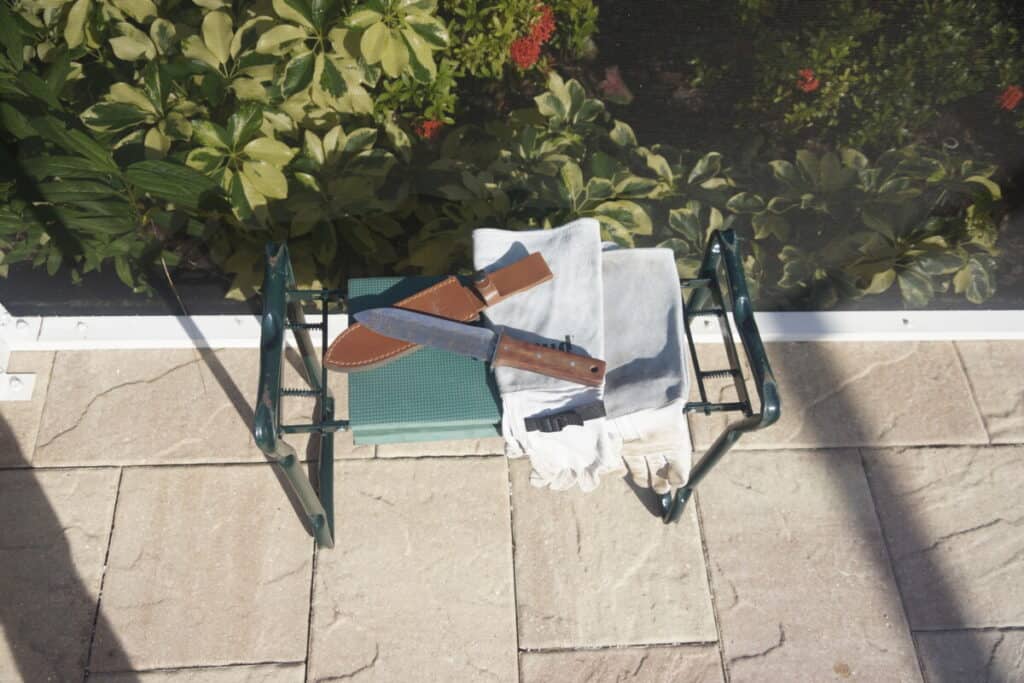
This has become my tool of choice for bulb planting. The knife blade is wide enough for digging and its serrated side is perfect whenever roots or debris are encountered. The inches needed for depth are clearly displayed and the point is better than a trowel for making trenches.
Bulb planting is a satisfying job and produces a beautiful and cost-effective result-but. It is repetitive! Try the knife out! It will save you time, and you will enjoy the work more.
Today I will add 100 caladiums, and with my favorite kneeler to move along I can make quick work of the job!
A Jeweler’s Eye Loupe
Really! Yesterday, I found a fuzzy substance on a small kumquat tree but could not see the source. However, with the folding loupe, I could see the tiny white dot turn into a moving mealybug and quickly deal with him and his family. Try one; they make problems smaller by making them look bigger!
When I attended my Master Gardener training class every student was given an inexpensive jeweler’s loupe. Today you will find them in all of our pockets!
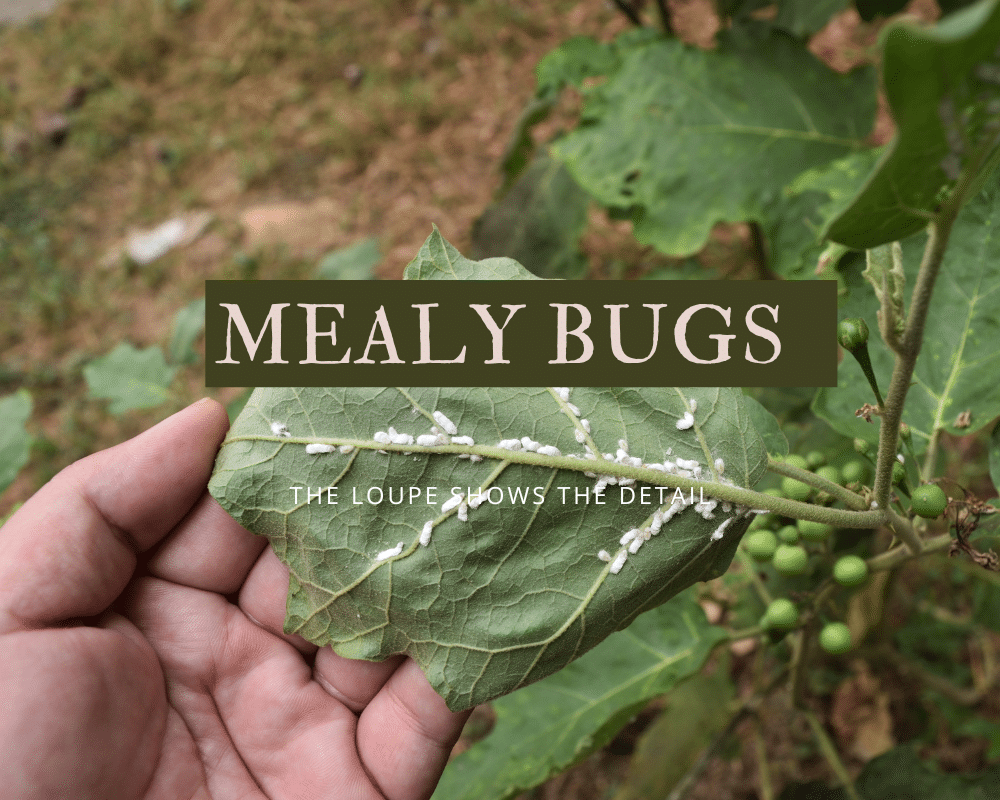
In March-Cooking Fresh from the Garden
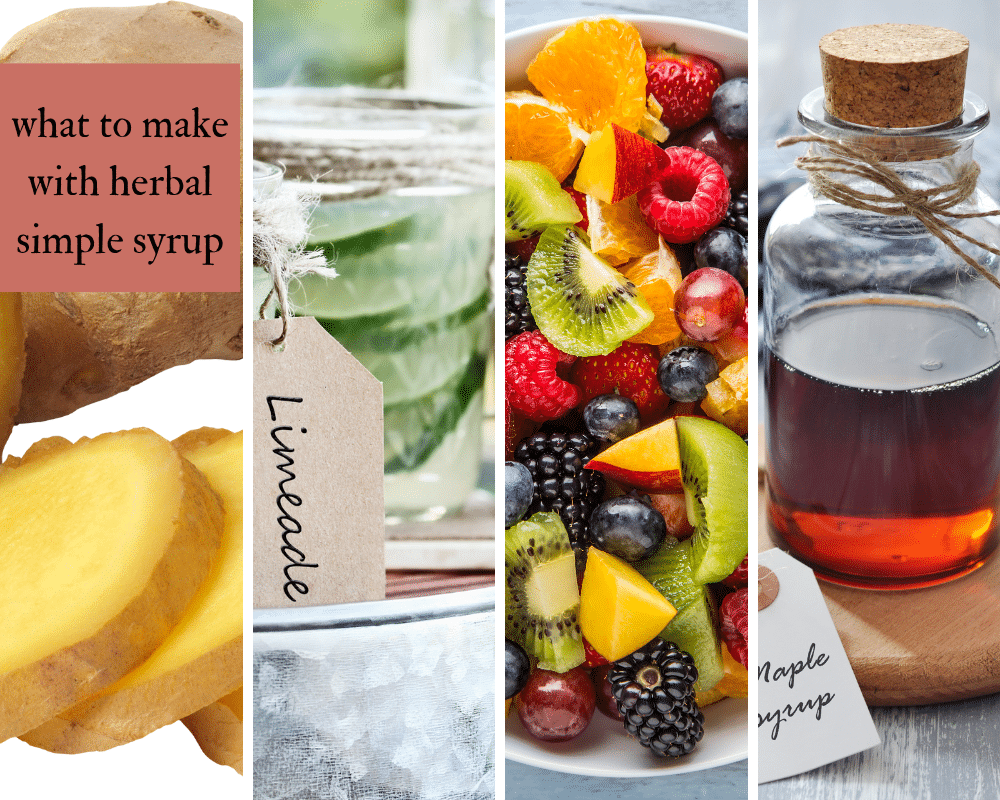
Last week we made a little brunch for Master Gardeners who worked on our spring garden lecture series. Our volunteer group hosts nine varied and expert lectures followed by a tour of a ‘secret garden’ in our beach town. We made champagne drinks and my warm weather specialty, ginger limeade with fresh ginger simple syrup. I added the syrup with the copious fresh mint from the poolside planter. A lovely refreshment for tired volunteers on a warm south Florida day! Here are the simple syrup recipe and some other ideas.
A Plant for March-with Botanical Latin so You Can Find It!
Pentas, Pentas lanceolata, is an easy to grow plant popular as a pollinator attractant. Commonly used as an annual plant for color, in warm climates such as our zone 10a garden it will last for several years. Creators of sweet nectar they will attract bees, butterflies and hummingbirds to their blooms.
Pentas produce groups of sparkling star shaped flowers in a variety of colors. They prefer full sun and well draining soil. The plants range from one to three feet. (Some are labeled dwarf varieties) and you can use them in the ground or in containers.
Summary,
March is more than planting, weeding and basketball! Named for the Roman god of war it signaled the start of the fighting season. Think of that as the weed get larger. If you spend more time on the phone than you consider ideal, remember that Alexander Graham Bell patented the thing in March!
But the critical significance of March is how it focuses our attention on growth and renewal. It is the month of change and heightened expectations. From now on in this year-anything can happen!
Small Gardens and Hurricanes
The garden I work in is small in size, big on ambition, and located in a region prone to hurricanes in the upcoming summer.
Here is what we have learned about producing small gardens that live big. I hope you like it
Preparing for Hurricane Season
Sign up below for my hurricane preparation checklist (just below), and we can all look forward to April.
